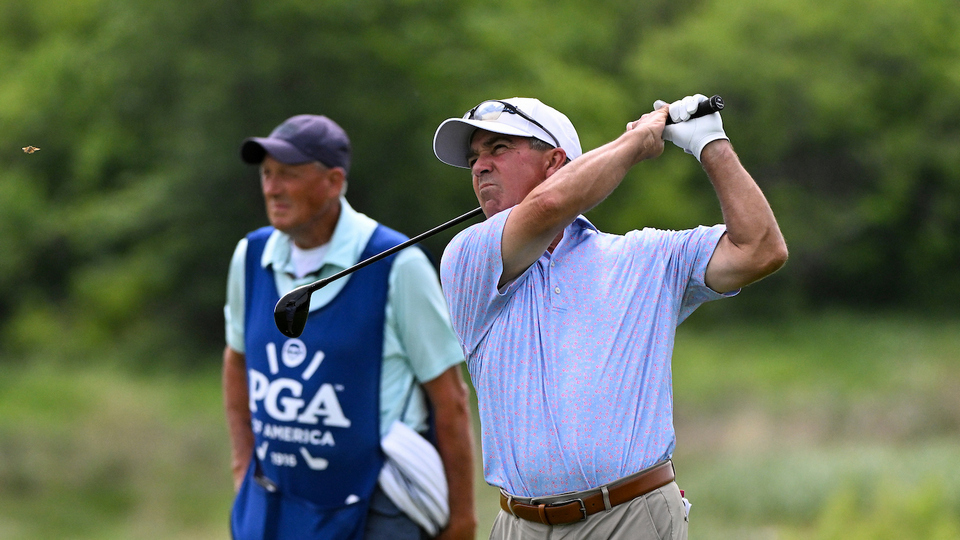LOUSVILLE, KY. The magical storyline that came from last year’s PGA Championship at Oak Hill was the engaging play of club professional Michael Block.
Block captivated the fans in attendance and a worldwide audience in making a dramatic hole-in-one during the final round and doing so in full view of his playing partner Rory McIlroy. The electric atmosphere was off the charts.
Block would secure a final par on the concluding hole assuring himself of an automatic exemption into this week’s event at Valhalla. Bravo indeed.
The romance of the underdog is always a compelling storyline in sports. Block provided that excitement but his performance belies the reality of club professionals when competing in the PGA Championship.
Block’s tie for 15th was the best by a club professional since Jay Overton secured a top 20 finish in the 1988 PGA Championship. The wherewithal for club professionals to compete against the best tour professionals is beyond a David and Goliath fable. At least David had a slingshot.
For many club professionals the goal when playing in the PGA Championship is simply to make the 36-hole cut.
There is no question club professionals are on the front lines daily with the fullest range of golfers. It is the PGA club professional who wears a range of hats in ensuring the needs of golfers are met. Those obligations and responsibilities are critical to the health of the game.
But to take that connection and then provide for twenty positions in the PGA Championship is overstating the case. The PGA of America awards the twenty leading finishers in its Professional Championship. There’s little question that some sort of availability into the PGA Championship needs to happen because of the foundation of what the PGA of America represents and what club professionals provide daily.
However, awarding twenty positions in a major championship is stretching a needed connection to the point where other players of stature can be shut out.
The bar for global golf talent is greater than ever. Younger players are coming onto the scene faster than ever before. The PGA TOUR saw the writing on the wall last year when it reduced those eligible for the FedEx playoffs from 125 to 70.
Securing placement in the most sought-after events is a never-ending discussion on what constitutes fairness and necessity. Someone will always make a case they deserve inclusion. You see that now with LIV players who have dropped in world ranking points because none are awarded for such competitions given the 54-hole format.
Ask most club professionals if they see the allocated number of 20 spots for the PGA Championship as being appropriate, and to a man, they all walk in lockstep that maintaining that number is a critical dimension in respecting the role they play as PGA professionals.

But competition at the elite level is a meritocracy. Providing for inclusions – a total of twenty total — when the bar for such involvement comes at a lesser level undercuts the nature of what a major championship is about.
Clearly, each of the four major championships can set the entry for their events as they see fit. Much of the criteria generally are relatively similar between them. The Masters is the lone exception as the club opts for a far smaller field when compared to the other three.
Setting aside spots for automatic inclusion is always going to be a contentious matter because for a full field event of 156 players there is always going to be someone who falls outside of consideration.
Having qualifiers for such prestigious events is a solid way to go. But all players competing in qualifiers are on the same level – there is no set aside carried out at a lesser level.

Reducing the number of exempt club professionals to ten instead of twenty will invariably produce howls about being less respected. Just keep in mind, the performance of Block would have gained him entry into Oak Hill since he finished in the top ten at the 2023 Professional Championship.
Keeping the club professional eligible for the PGA Championship shows a connection that must be maintained.
The issue is just how many spots should be awarded for that involvement?
Doing a deep dive analysis on this matter is something the brain trust of the PGA of America must decide upon.
For years the PGA Championship routinely boasted about having the strongest field of any of the majors. Reassessments are now about weakness but serve notice that all steps are being explored to get the best players into a given field.

The PGA Championship has made great strides in elevating its stature. Host sites are among the finest in the sport. The movement of the event from August to May has helped considerably in maxing out fan interest.
Club professionals are a central part of the mission for the PGA of America. Reducing that number in half is not a punishment but a clear statement of reality. Securing the best of players is a critical acknowledgement that all is being done to elevate the event.
The time is now.


